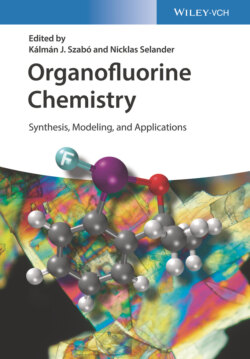Читать книгу Organofluorine Chemistry - Группа авторов - Страница 8
1.1 Introduction
ОглавлениеFor a long period of time, fluorine chemistry research was deemed to be very dangerous, in part owing to the notorious fluorination reagents such as F2 and HF, which are highly corrosive and reactive. In this context, synthetic organofluorine chemistry was only pursued by a handful of researchers for several decades after the first synthesis of F2 by Moissan in 1886. However, great changes had taken place over the past decades. With the successful application of chlorofluorocarbons (although banned later owing to their ozone‐depleting character by Montreal Protocol in 1987) as refrigerants, the development of high‐performance fluorinated materials such as Teflon and the development of fluorinated pharmaceuticals and agrochemicals, organofluorine chemistry has become increasingly important in satisfying the huge demand for fluorinated molecules with diverse functions [1]. To date, organofluorine chemistry has become an indispensable branch of organic chemistry and enriched many aspects of related areas such as medicinal chemistry and materials science, among others. Perhaps the most prominent application of organofluorine compounds that has close relation with our everyday life is fluorinated drugs. For example, among the 59 drugs (39 of them are small molecule drugs) approved by FDA in 2018, 18 contain at least one fluorine atom; among the 48 drugs approved by FDA in 2019, 13 contain at least one fluorine atom [2]. Some representative fluorinated drugs approved in 2018 and 2019 are shown in Figure 1.1.
In spite of the importance of fluorinated molecules in modern society, naturally occurring organofluorine compounds are rare [3]. Basically, all the commercially supplied organofluorine compounds are manmade. Thus, the development of new reagents and reactions to introduce fluorine atoms or fluorine‐containing moieties into organic molecules is one of the central goals in modern synthetic organofluorine chemistry.
Figure 1.1 Fluorinated drugs newly approved by FDA in 2018 and 2019.
Figure 1.2 Organofluorine reagents developed or co‐developed by us.
Over the past 15 years, our group has been interested in reaction mechanism‐inspired synthetic organofluorine chemistry [4]. We have developed or co‐developed a variety of reagents, including fluoroalkyl aryl sulfones [5], fluoroalkyl sulfoximines [6], fluoroalkyl heteroaryl sulfones [7], difluorocarbene reagents [8], fluorinated sulfinate salts [9], fluorinated esters [10], CpFluors [11], and SulfoxFluor [12], among others (for a review, see Ref. [4d]), for fluoroalkylation, fluoroolefination, and fluorination reactions (Figure 1.2). Our research program was triggered by two questions: (i) What are the unique features of organofluorine reactions (compared with regular organic reactions)? (ii) Is there any relationship among fluoroalkylation, fluoroolefination, and fluorination? In this review, we intend to answer these two questions by illustrating representative reagents and reactions developed (or co‐developed) by us. In particular, understanding of the unique fluorine effects in organic reactions is helpful in addressing these two questions [4g].
